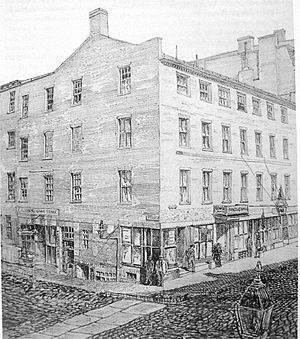Concert Hall (Boston, Massachusetts) facts for kids
The Concert Hall was a popular place in Boston, Massachusetts, where people gathered for over a hundred years. It was located at Hanover Street and Queen Street. Many different events happened there, including concerts, meetings, and fancy dinners. It was a very important spot for Boston's social and cultural life.
Contents
The Concert Hall: A Historic Boston Venue
Building History and Design
The Concert Hall building was built in 1752, possibly by Stephen Deblois. Before it became the Concert Hall, the land it stood on had many different owners, going all the way back to the 1600s when Boston was first settled. It was even known as "Houchin's Corner" for a while.
Over the years, the building changed hands several times. Some of its owners included Gilbert and Lewis Deblois, Stephen Deblois, William Turner, and John and Jonathan Amory.
How the Building Changed
After 1787, a famous architect named Charles Bulfinch redesigned the inside of the building and made it bigger. Around 1798, it was described as a "brick house, three stories, thirty windows." The Concert Hall was updated many times until it was finally taken down in 1869. This happened to make way for a wider street called Hanover Street.
Fun Events and Gatherings
The Concert Hall was used for many different things. It was mainly a place for groups of people to meet and enjoy themselves.
Music and Performances
Concerts were a big part of the Concert Hall's history. As early as 1755, newspapers advertised "a concert of musick" there. The hall might have even had a small organ from London between 1763 and 1774.
John Rowe, a well-known Boston merchant, often went to events at the Concert Hall. He wrote about them in his diary:
- On March 16, 1769, he enjoyed a concert, saying it had "the best musick I have heard performed there."
- On March 23, 1770, he saw Mr. Joan read and sing from "the Beggars Opera." He thought Mr. Joan sang well, even if his reading wasn't great.
- On January 3, 1771, he attended a concert and dance with many important people.
- On October 15, 1771, he went to a concert by Mr. David Propert, with over 200 people attending.
Josiah Flagg, a musician born in 1737, also performed many concerts at the hall. In 1770, he gave a "Grand concert" that included singing. In 1771, his concert program featured many different types of music, including pieces by famous composers like Handel and J.C. Bach. Flagg also helped organize events, like a concert in February 1771 that featured a violinist and a military band.
Other musicians, like David Propert (an organist) and Mr. Selby (who played the harpsichord), also gave concerts at the hall.
Dances and Parties
The Concert Hall was a popular spot for dancing. In 1762, Charles Pelham advertised dancing lessons there. Later, Thomas Turner also taught dancing and fencing at the hall in 1776.
Many fancy balls were held at the Concert Hall in the 1770s. For example, a "Subscription Ball" was held in January 1776. There was even a "Subscription Masked Ball" in March 1776, where people wore costumes. In 1778, Governor John Hancock hosted a huge ball for French officers, with 300 guests attending.
Other Cool Shows
Besides music and dancing, the Concert Hall hosted other interesting performances in the 1800s.
- In March 1831, a ventriloquist named Jonathan Harrington performed.
- In March 1834, a very large 8-year-old named Rose Rich appeared at the hall.
- In September 1835, a woman named Joyce Heth, who claimed to be 161 years old and George Washington's former nurse, was shown there.
Some truly unique acts also visited. In 1804, a performer named Mr. Rannie was a sword-swallower and ventriloquist. He even had a "surprising fish" that could pick out any card a person thought of!
Important Meetings
The Concert Hall was also a place for important meetings. The Freemasons met there for many years, starting in the 1750s. From around 1789 to 1846, the Society of the Cincinnati of Massachusetts held their yearly meetings there.
In December 1833, a special dinner was held at the Concert Hall to celebrate Chandler Robbins becoming a minister. One person who attended noted that the dinner was very fancy, but only water and coffee were served to drink.
People also met to discuss important topics, like the "Missouri Question" in 1820, which was about whether new states would allow slavery.
Who Ran the Hall?
Several people helped manage the Concert Hall over its history. James Vila was in charge from 1789 for many years. Tilley Whitcomb was also involved around 1805. For a long time, Peter Bent Brigham oversaw the hall, starting around 1837. Around 1840, Henry Hannington was known as the "proprietor of the celebrated Dioramas" shown at the Concert Hall.


